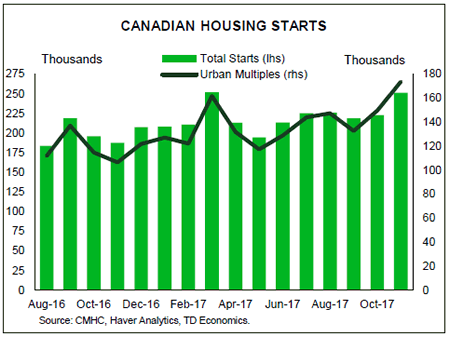U.S. Highlights
- Investors celebrated tax cuts by snapping up U.S. equities this week, extending last year’s record-setting rally into the first week of 2018. Energy stocks were lifted as WTI hit $62 for the first time since 2014.
- December’s solid jobs report capped the end of a stellar year for the labor market as the unemployment rate remained at a 17-year low of 4.1%. Overall, 2.2 million jobs were added in 2017.
- In 2018, tax cuts will provide employers with more ammunition for pay upgrades, which will help inflation edge higher. We expect the Fed to hike twice in 2018, with inflation expected to reach 2% later this year.
Canadian Highlights
- The hot streak in Canada’s labour market continued, with a robust 79k jobs added in December.
- Other details of the jobs report were similarly upbeat, with the unemployment rate falling to a multi-decade low, hours worked surging and wage growth holding near 3%.
- For a data dependent Bank of Canada, across-the-board labour market strength likely seals the deal on a January rate hike.
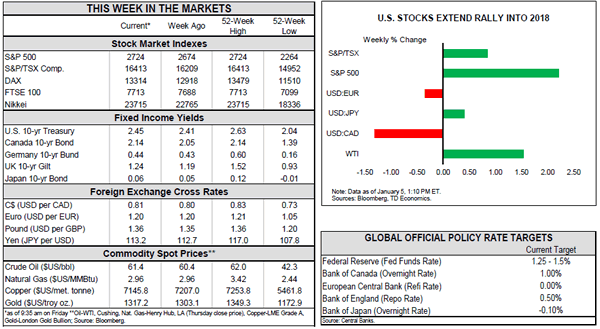
U.S. – Economy Added 2.2 Million Jobs in 2017
Investors celebrated tax cuts by snapping up U.S. equities this week, extending last year’s record-setting rally into the first week of 2018. The Dow Jones Industrial Average, S&P 500 and Nasdaq Composite reached fresh highs, owing to rising profit expectations and strong fundamentals. Energy stocks were lifted as WTI hit $62 for the first time since 2014, a result of strong global demand that has fueled a production boom and helped drain oil surpluses. Strong activity was reflected in global manufacturing indices in December. The U.S. ISM manufacturing index reached its highest annual level since 2004 in 2017, while similar indices in the Eurozone, China, and the UK also reflected roaring factory activity (Chart 1).
Production has been supported by solid spending figures, with U.S. vehicle sales in December being a prime example. Auto sales rounded out 2017 strongly, helping make the annual total the fourth best in history for auto dealers. Although pent-up demand for vehicles dwindled over 2017, sales in 2018 should continue to be supported by lengthening loan terms and tightening labor markets. Moreover, personal income tax cuts should provide an additional boost to demand.
Tax reform was also a topic discussed by the FOMC in December. The pace of monetary policy normalization could increase to offset any inflationary pressures that materialize from the plan. This prospect sent the U.S. dollar higher temporarily while the ten-year benchmark bond yield rose. Still, the Committee expressed concern over low inflation that has remained despite persistent labor market tightening.
Indeed, this morning’s data confirms that the U.S. labor market continues to tighten. December’s solid jobs report capped the end of a stellar year for the labor market as the unemployment rate remained at a 17-year low of 4.1% for the third consecutive month. Strong hiring brought the total jobs added in 2017 up to roughly 2.2 million, outperforming 2016 (Chart 2). As the labor market approaches full employment, the pace of hiring will subside as the unemployment rate stabilizes in the medium term. Employers will have to dole out larger pay increases in order to attract and retain workers. And, with tax cuts providing more ammunition for pay upgrades, it is just a matter of time before inflation edges higher. Additionally, the recent increase in commodity prices may squeeze profit margins further, and should translate into consumer price increases as the year progresses. Next week’s CPI report should illustrate the extent to which this has impacted price growth in December.
All told, the strong finish to 2017 provides ample momentum for a pickup in growth in 2018. We still expect the Fed to hike twice in 2018, assuming that inflation builds steadily, reaching the Fed’s 2% target later this year. However, political uncertainties still loom large. This includes a federal budget resolution, as temporary funding runs out on the 19th of this month. Although another short-term extension could be passed in order to curtail a government shutdown, several contentious issues will eventually need to be addressed.
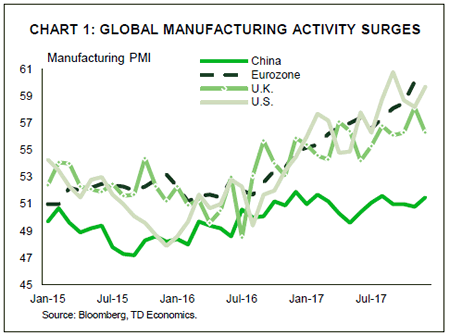
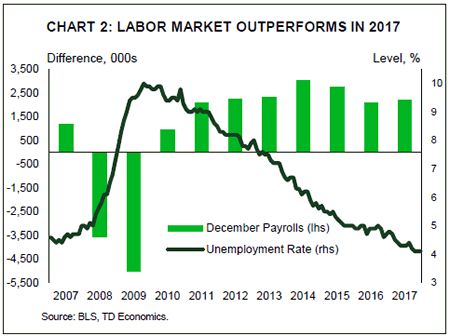
Canada – Blowout Jobs Report Supports January Rate Hike
The economic calendar began the New Year on a relatively quiet note. However, this soon gave way to end-of-week fireworks with a blowout jobs report sending yields and the loonie higher. Meanwhile, markets shrugged off a weak merchandise trade report and oil rose further above $60 on optimism surrounding global growth, tensions in Iran and supply disruptions in Libya.
December’s jobs report stole the show this week, shattering expectations with a massive gain. Recall that employment surged by 80k in the prior month, leading observers to expect some payback in December. However, this simply did not materialize, as employment jumped 79k in the month, leading Q4 to the strongest quarterly gain since 2010. Other aspects of the report were similarly positive, with the unemployment rate falling to a multi-decade low of 5.7% (Chart 1), labour force participation increasing, hours worked surging and wage growth holding near 3%. Furthermore, employment increased in every province, led by Quebec and Alberta. Quebec’s unemployment rate now sports a "4-handle" and is nearly 1 percentage point lower than the national figure. Notably, employment in the finance, insurance and real estate sector was up a robust 4.6% year-over-year in December, providing some comfort ahead of the implementation of the B20 guidelines. For the year as a whole, employment increased by 423K, marking a significant acceleration from 2016 and the fastest December-to-December gain since 2002 (Chart 2).
If there were a minor quibble in today’s data, it was that the gain skewed towards part-time work. Moreover, youth employment, flagged by Governor Poloz as an on-going concern, dipped modestly following three straight gains. While the Governor continues to fret about declining youth participation, we contend in an upcoming report (out on Tuesday January 9th) that this phenomenon is explained by rising school enrolments – a positive long-term development. Hence, in our view this shouldn’t be a roadblock preventing the Bank from taking rates higher, particularly in an environment of excess demand and rising core inflation.
Despite some wrinkles, today’s jobs report was overwhelmingly solid and points to economic growth ending the year on a solid footing. This is important as a sharp hike in Ontario’s minimum wage took effect on January 1st, casting a shadow on the labour market outlook. For a data dependent Bank of Canada, across-the-board labour market strength in December likely seals the deal on a January rate hike, though one potential fly in the ointment could be the upcoming winter Business Outlook Survey (out Monday January 8th). However, a very weak report would probably be needed to dissuade a January move. We do not view this as a likely outcome given a healthy labour market, rising inflation and a solid economic backdrop during the survey period. As such, we look for the Bank to take rates higher on January 17th. That would certainly be an interesting way to ring in the New Year.
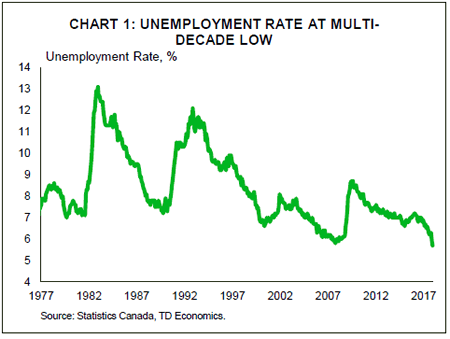
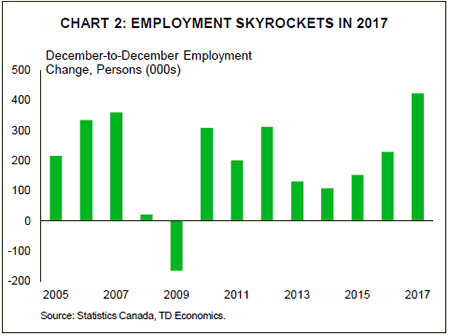
U.S.: Upcoming Key Economic Releases
U.S. Consumer Price Index – December
Release Date: January 12, 2018
Previous Result: 0.4% m/m, core 0.1% m/m
TD Forecast: 0.1% m/m, core 0.2% m/m
Consensus: 0.2% m/m, core 0.2% m/m
We expect headline CPI inflation to moderate to 2.1% y/y in December, with prices up a seasonally adjusted 0.1% m/m. Energy prices should be a net positive, led by higher gasoline prices but partially offset by higher natural gas and electricity prices. We maintain a cautious view on grocery prices, which have declined in the prior four months. Excluding food and energy, we expect core CPI to print a 0.2% m/m increase after disappointing with a relatively weak 0.1% rise in November. Much of the prior month’s weakness, notably in hotel prices, airfares, and physician’s services, is likely to reverse, with the exception of apparel. Our forecast suggests core inflation should stabilize at 1.7% y/y. Going forward, USD weakness and rising commodity prices should provide a net tailwind and allow core prices to firm gradually over the course of 2018.
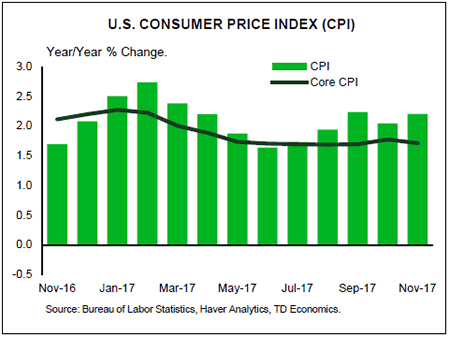
U.S. Retail Sales – December
Release Date: January 12, 2018
Previous Result: 0.2%, ex-auto 0.1%
TD Forecast: 0.2%, ex-auto 0.1%
Consensus: 0.5%, ex-auto 0.4
We expect retail sales to rise 0.2% in December, a relatively modest gain but consistent with Q4 real consumer spending near a robust 3%. Motor vehicle sales are likely to be a small positive, in line with the better than expected pickup in light weight auto and truck sales (17.8m vs 17.4m previously). Gasoline station receipts will likely make a neutral to negative contribution due to lower gasoline prices, while the cold snap in winter temperatures suggests a hit to spending on building materials and at restaurants. We also expect a modest 0.1% rise in the control group (excluding auto, gasoline station, food services and building material sales), mostly reflecting a moderation following the unsustainable strength in the prior three months.
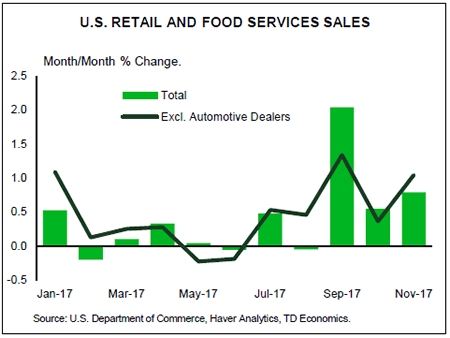
Canada: Upcoming Key Economic Releases
Canadian Business Outlook Survey
Release Date: January 8, 2018
The BOS will balance an positive assessment of business conditions against the persistent threat of restrictive trade measures. We expect firms to note an increase in foreign demand on stronger growth south of the border, though concerns over the future of NAFTA may receive more prominence after a contentious turn in negotiations. Ongoing competitiveness challenges may also receive mention after a sharp cut to the US corporate tax rate. After the last survey noted an increase in the intensity of labour shortages, any notion of labour market slack will be downplayed amid the creation of another 193k jobs over the last three months. Firm-level inflation expectations could also edge higher to reflect recent strength in CPI. On balance, we expect the report to deliver a constructive tone which should clear the way for the Bank to hike in January.

Canadian Housing Starts – December
Release Date: January 9, 2018
Previous Result: 252k
TD Forecast: 225k
Consensus: N/A
Housing starts are forecast to slow to a 225k pace into year-end, reflecting a more modest pace of multi-unit construction. Multi-unit starts hit their highest level on record in November and are unlikely to sustain such a pace in light of a more sluggish demand environment. As such, we expect a pullback in multi-family starts to drive the headline result. Single family starts should prove more stable though a blanket of cold weather will weigh on construction for all home types.
Chart: Canadian Employment
